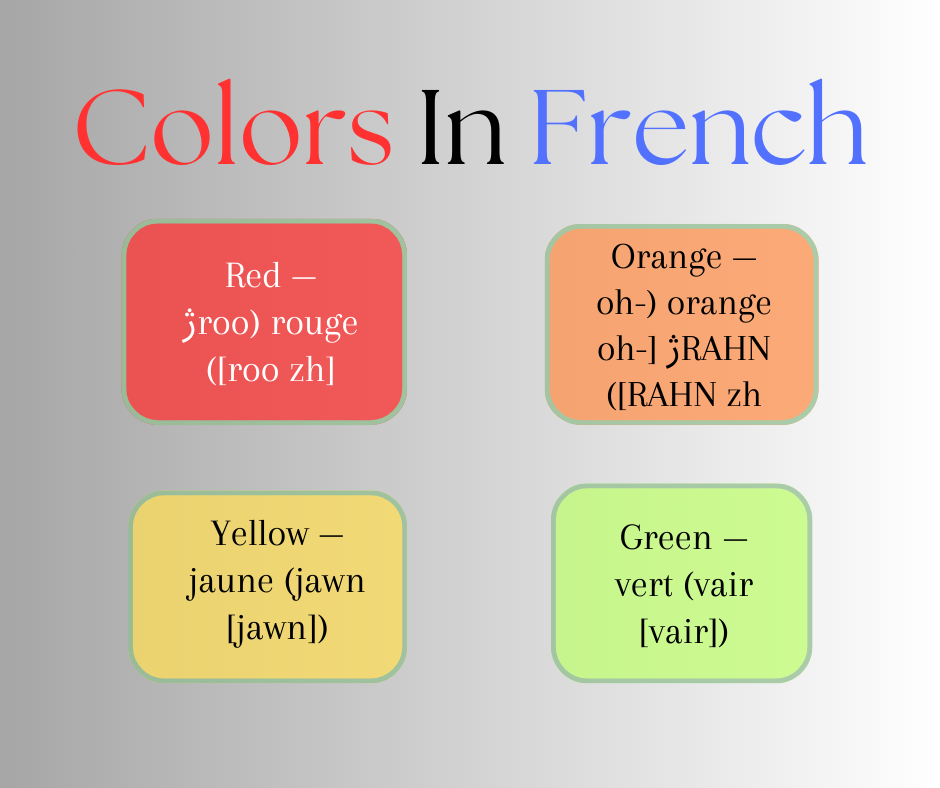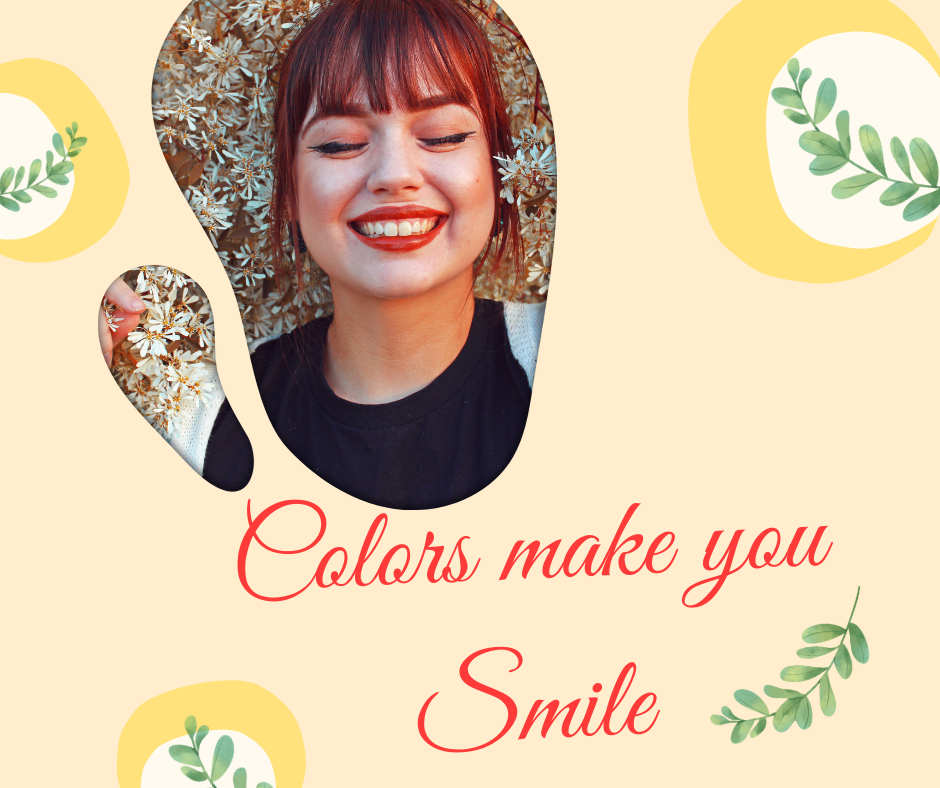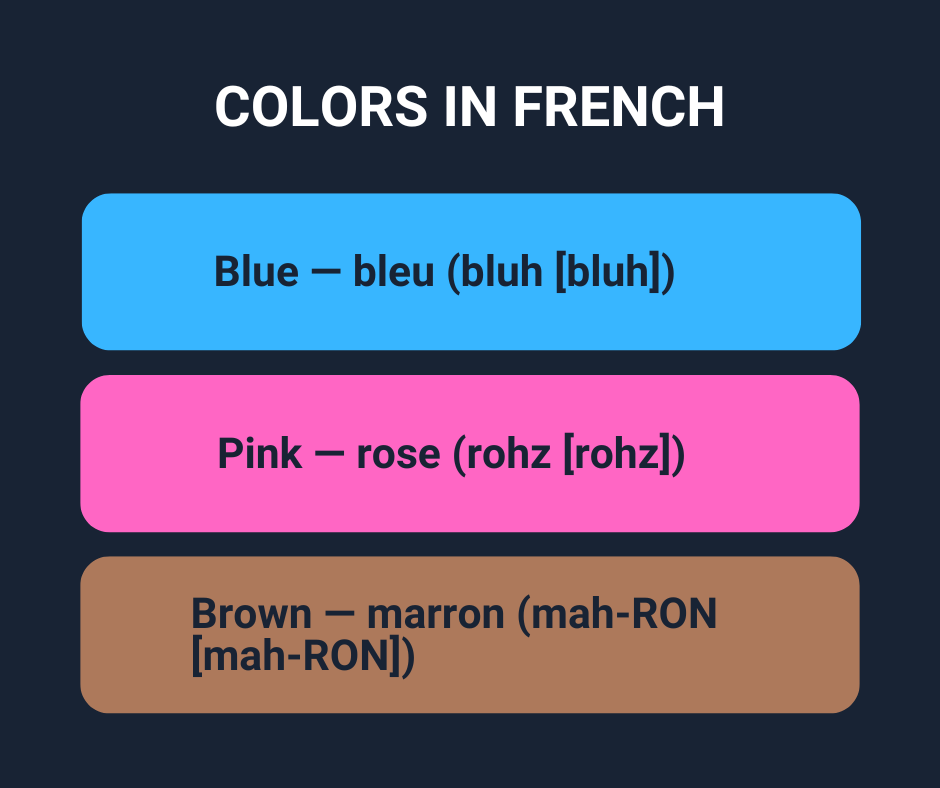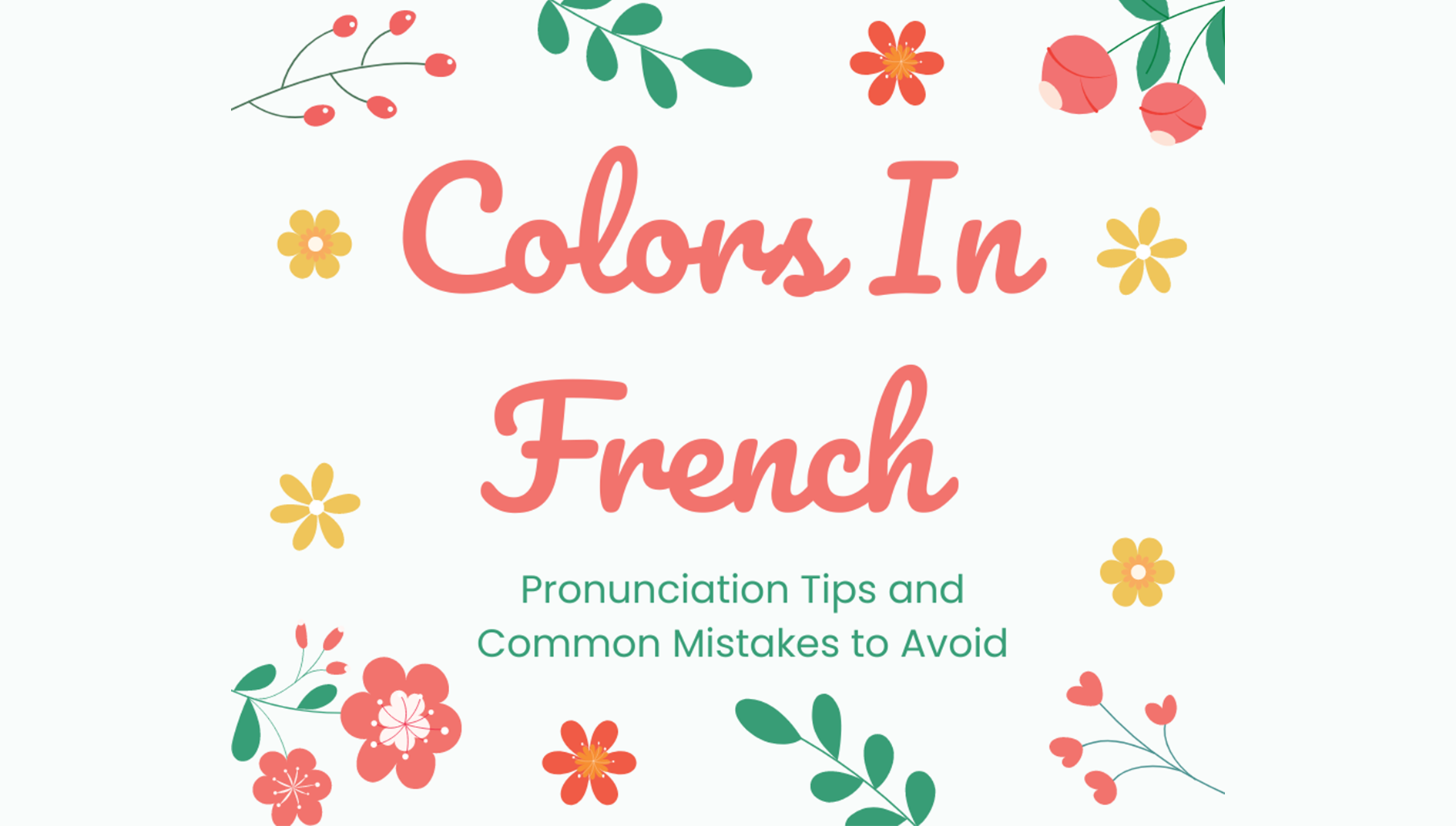Colors are the fabric of our world, painting the canvas of our experiences and shaping how we perceive the world around us. Whether admiring a vibrant sunset or describing the shade of our favorite sweater, colors are integral to our daily conversations.
In this guide, we tackle the unique challenge of colors in French, exploring pronunciation tips and common mistakes to avoid. Unlike English, where color names remain fixed, French adds a layer of complexity with its adherence to gender and number agreement. This means that each color can take up to four forms, depending on the noun it accompanies.
Mastering colors in French is about more than just learning a new set of words. It’s about equipping yourself with a powerful tool for effective communication. To truly enhance your descriptive abilities and overall communication skills, you must learn the nuances of color vocabulary.
As Mark Twain once said, using the wrong word can make all the difference. Therefore, it’s not just a suggestion but a necessity that you try to master the colors in French to take your language skills to the next level.
For instance, imagine describing a beautiful painting by Monet. Would you settle for vague descriptions, or would you strive to capture the essence of his masterpiece with precise color vocabulary? Mastering colors in French opens doors to more affluent, more descriptive expression, allowing you to paint vivid pictures with your words.
Let us take you on a journey through the kaleidoscope of French colors, where each shade holds a world of meaning. Let’s begin a colorful adventure together as we unravel pronunciation mysteries and avoid common pitfalls. Remember, we’re all learners here, and together, we can master the intricacies of French color vocabulary.
Colors in French – Essential Pronunciation Tips
Are you ready to dive into the fascinating world of French colors? At first glance, it might seem like a simple task of memorizing a few vocabulary words like bleu (blue), rouge (red), and vert (green). Mais non (but no)! Colors in French are much more than words – they are cultural expressions that make this language so vibrant.
In this exciting exploration of “Colors in French – Essential Pronunciation Tips,” we will take a thrilling look into the linguistic intricacies of French colors. We will understand beyond the surface-level vocabulary and discover the hidden shades of meaning that colors bring to everyday language.
Here’s your vibrant French color palette, complete with the method to pronounce them:
Red — rouge (rooژ [roo zh])
The “g” at the end is silent, and the “ou” makes a sound similar to “oo” in “boot.”
Red is a powerful color associated with many emotions, as shown in the French language and culture. In French, the color red expresses anger, passion, and vulnerability. What’s interesting is that the word “rouge” remains the same whether it’s used to describe a singular or plural noun, regardless of gender. It shows that the power of red transcends language barriers. For example, we can use “rouge” to describe the color of Mars or fire trucks.
Orange — orange (oh-RAHNژ [oh-RAHN zh])
Similar to English, the final “e” is silent.
Have you ever wondered whether the fruit or the color came first when it comes to oranges? It’s a debate that has intrigued many for years! Interestingly, in French, the word “orange” is directly related to the fruit, l’orange, which has a long and rich history. This is also the case in English, making it a fun fact for language learners.
What’s really cool about the French language is the way “orange” is used as an adjective. Unlike most adjectives, it doesn’t change to agree with the gender or number of the noun it modifies. This is because “orange” originally comes from a noun, which makes it unique.
For instance, “J’adore les tulipes orange” means “I love orange tulips,” and the use of “orange” as an adjective makes it easy to describe the color of the tulips.

Yellow — jaune (jawn [jawn])
The “u” makes a sound close to the “w” in “water.”
Yellow is a bright color representing vitality, optimism, and joy. In French, the word for yellow is “jaune,” which is consistent in both singular and plural contexts, making it easier to use in language. For example, you can say “J’ai un T-shirt jaune” to describe a cheerful yellow t-shirt or “Les tournesols sont jaunes” to evoke the image of sunflowers basking in the sun.
“Jaune” is more than just a color description; it captures the essence of beauty in the world around us. From the gentle glow of a candle flame to the bold brilliance of a sunflower field, “jaune” reminds us of nature’s boundless warmth and radiance.
Green — vert (vair [vair])
Pronounced like the first part of “very.”
Green is a popular color worldwide, symbolizing vitality, renewal, and harmony. In French, the adjective “vert” adapts well to gender and number, making it versatile for describing different things. For example, it can be used to describe the color of a refreshing cup of green tea, an elegant green dress, or a wardrobe infused with the vibrant spirit of nature. It can also describe the lush greenery of a thriving garden. Beyond its aesthetic appeal, “vert” carries symbolic weight, embodying growth, balance, and environmental consciousness concepts. It serves as a reminder of our interconnectedness with the natural world and the importance of preserving its lush landscapes. So, whether admiring the emerald foliage of a forest canopy or savoring the crisp flavor of fresh greens, “vert” invites us to embrace the vitality and abundance inherent in the world.
Blue — bleu (bluh [bluh])
A simple and straightforward pronunciation.
Blue is the world’s most popular color, evoking emotions from tranquility to sadness. In French culture, blue holds an essential place as the color of choice for national sports teams. The French football and rugby teams are particularly revered, and their fans can be heard shouting “Allez les bleus” in support. What makes the color so fascinating is its spectrum of shades, each with a unique character. French adjectives like “clair” and “foncé” describe the nuances of blue, adding depth and dimension to our perception of the color. Even more impressive is how adaptable “bleu” is in French, gracefully adjusting to agree with the gender and number of the objects it describes. From the ocean to sports jerseys, blue is a captivating color that invites us to explore its boundless beauty.

Pink — rose (rohz [rohz])
The final “e” is silent, and the “o” makes a short “oh” sound.
The color “pink” represents charm and sweetness. It’s a delicate color that can add a touch of whimsy to any palette. However, in French, it’s important to distinguish between “rose,” the color, and “rose,” the flower, to avoid any confusion in communication.
What’s interesting about “rose” is that, unlike some color adjectives, it gracefully adapts to agree with the noun it describes. It means that whether it’s a singular or plural object, the form of “rose” shifts accordingly.
For example, you could say “J’ai acheté une chemise rose” to describe a shirt with a soft blush of pink that adds a dash of elegance. Or, you could say “J’ai acheté des lunettes roses” to describe a pair of pink glasses that add a playful and whimsical flair to your ensemble.
But, “rose” isn’t just a color—it symbolizes femininity, tenderness, and grace. It transcends mere visual appeal and evokes a sense of warmth and affection wherever it’s found.
Brown — marron (mah-RON [mah-RON])
The double “r” creates a slightly stronger vibration than a single “r.”
Brown represents warmth, solidity, and strength. In French, the term “brown’ is called “marron,” which comes from the chestnut fruit. The exciting thing about “marron” is that it remains the same regardless of gender or number, just like the color “orange.” This shows how language and nature are connected.
“Marron” is a beautiful color that can add depth and soulfulness to a person’s gaze or infuse warmth and character into furniture. It’s not just a visual description; it represents a sense of rootedness, stability, and authenticity. It reminds us of our connection with the natural world and the timeless beauty of the earth beneath our feet.
Black — noir (nwaር [nwaር])
The final “r” is silent, and the “oi” makes a sound close to “wa” in “water.”
In fashion, black is an iconic and timeless color. It is represented by the famous little black dress pioneered by French designer Coco Chanel in the 1920s. Black is a symbol of elegance and sophistication, transcending trends and generations.
In French culture, expressions featuring the word “black” are used often, adding depth and intrigue to everyday language. From “the black hole” to “dark chocolate,” these phrases evoke a sense of mystery and intensity, highlighting the many facets of the color.
Black represents depth, mystery, and resilience. It serves as a canvas for expression, encouraging us to embrace the timeless allure of this iconic color.
White — blanc (blahn [blahn])
The “c” is silent.
In the world of colors, “white” symbolizes purity, clarity, peace, and illumination. It is significant in the French flag, representing the monarchy and the symbolic blue and red.
The word “blanc” is versatile and can be adapted to match the gender and number of the nouns it describes.
It captures the imagination and inspires awe, whether adorning the landscape in a blanket of snow or a bride in timeless elegance.
In a nutshell, “blanc” reminds us of the enduring beauty of simplicity and light.
Gray — gris (gree [gree])
It is pronounced similarly to “green” in English but without the final “n.”
Grey is a color that exudes elegance, versatility, and sophistication. It’s a neutral shade that is celebrated for its timeless appeal. As the French Neoclassical painter Jean-Auguste-Dominique Ingres once said, “Better grey than garishness,” highlighting the refined allure of this color.
In French, the adjective “gris” adapts to agree with the gender and number of the nouns it describes, with only the feminine form undergoing alteration. Whether the distinguished charm of grey hair adds character and wisdom to an individual’s appearance or the muted sophistication of grey dresses that exude effortless style, “gris” embodies a sense of subtlety and balance.

Common Mistakes to Avoid While Using Colors in French
Learning French colors is an essential part of mastering the language. However, it’s easy to make mistakes that can impact your understanding and pronunciation. Let us discuss the common mistakes to avoid while using colors in French.
- Unlike some languages, French color adjectives maintain consistent pronunciation regardless of gender or number. To avoid confusion, pay attention to other grammatical aspects.
- In French, the color typically follows the noun it describes, unlike in English. It leads to confusion and errors in sentence construction.
- Colors must correlate to gender and the number of the nouns they modify. Some colors require additional modifications, so it’s essential to pay attention to gender and number agreements.
- Be aware of exceptions such as “marron” and “couleur,” which don’t change form based on gender or number. Additionally, “gris” remains unchanged in its masculine form but requires an extra “e” in its feminine form.
With dedication and attention to detail, you can confidently and precisely navigate the colorful world of French. Avoiding common mistakes and practicing diligently will help with the skills necessary to communicate effectively and beautifully in this rich language.
Takeaway
Are you eager to master French colors? Then look no further! Whether you’re learning French for the first time or looking to brush up your skills, mastering French colors is essential to your linguistic repertoire. But don’t worry; with a bit of practice and attention to detail, you’ll quickly understand the intricacies of French color grammar.
To get started, clarity and consistency are vital in pronunciation. Using the tips, you can confidently master French color vocabulary and pronunciation nuances while avoiding common mistakes. Remember to pay attention to the noun-adjective order, placing the color after the noun as per French convention. Additionally, be mindful of gender and number agreement, adapting color adjectives accordingly to match the noun they describe.
While there are exceptions to be aware of, such as irregular forms and unique cases like “marron” and “couleur,” diligent practice and attention to detail will aid in mastering French colors with accuracy and finesse. Incorporating these tips into your daily practice will expand your linguistic repertoire and deepen your understanding of the French language and culture.


 May 6, 2024
May 6, 2024  11 Min
11 Min  No Comment
No Comment 



